Feeder fishing is fundamentally different from the usual one (rod), because in order to achieve a good result, perhaps the most important thing is preparatory stage, namely the correct selection and preparation of bait.
Here it is important to consider everything:
- type of reservoir;
- type of fish;
- season;
- the quality of the batch, the correct ratio of ingredients.
In the article, we will analyze in detail the components of complementary foods for feeder fishing for bream and all the nuances associated with this. As you know, there are no trifles for a good fisherman, because even a small miscalculation can ruin a day allocated for fishing.
Use store-bought or make your own?
Everyone decides this question for himself. But there is a question of rationality - if fishing is carried out for several hours on a previously untested reservoir, then the easiest way is to buy ready-made bait, and fill the feeder with this mixture.
Here are a few trusted brands:
- sensas. Manufacturer from France, has proven itself well in domestic open spaces;
- Traper. Representative of Poland. There is a whole line of products for all occasions. You can pick up bait for specific conditions, which is guaranteed to lead to a good catch;
- Dunaev. This is a cheaper analogue, which is produced by us. There are several options that differ in cost and purpose. Quite a decent product.
However, the bream is a rather voracious fish, therefore it requires good and plentiful food at the place of fishing. Therefore, you can go broke on purchased components. Hence the pattern - avid fishermen always prepare mixtures on their own.
If you choose the right recipe and carefully approach the process, it turns out no worse than factory counterparts.
Another trick is to add it to homemade bait a small amount of purchased. Thus, elements are added that are inaccessible to a simple layman.
Components of bait
Regardless of the method of fishing (rod, feeder), the main ingredients remain unchanged. Bait must perform several functions at the same time, so the components are divided into several groups.
We create haze
In muddy water, bream can stay for a long time; for cautious fish, this is the best environment.
To please the fish in this regard, they usually use:
- powdered milk;
- semolina;
- various dough;
- ordinary bread;
- purchased ingredients.
The basis of nutrition
After the conditions for eating have been created, you need to provide the bream with a favorite treat.
Suitable for this:
- pearl barley;
- corn;
- peas;
- buckwheat (necessarily fried);
- millet;
- bran.
flavoring
This underwater inhabitant is able to smell food at a distance of 200 meters.
And to help him do it faster, you can use:
- vanillin;
- coriander;
- ground coffee;
- purchase options that will not cost a lot of money.
Connecting elements
It is especially important to use these components when fishing on the current.
You can use the following options:
- clay;
- ground dry peas;
- oat flakes;
- Wheat flour.
Dyes
As mentioned above, bream is a very cautious fish, therefore, even the best bait with an intoxicating aroma, but radically different in color from the aquatic environment, will scare off individuals.
There is a set of rules for this ingredient, which will definitely be covered a little later.
Making your own food
There is a set popular recipes for different seasons and features of the reservoir. Let's consider this question in more detail.
Particular attention should be paid to viscosity. Small particles should quickly wash out of the feeder, forming a fragrant cloud that attracts. The main food is washed out gradually, keeping the future catch in place.
but too thick consistency will lead to the fact that after swallowing the cloud, the bream will not find large particles and leave.
Recipe one. Summer, standing water (pond, lake)
For cooking you will need:
- breadcrumbs- 0.3 kilograms;
- sunflower seeds - about 200 grams (required in ground form);
- bran - 0.3 kilograms;
- millet porridge - the same 300 grams;
- two thirds of a teaspoon of ground coriander;
- clay, the amount of which is selected experimentally.
Recipe two. Summer, river
You need to stock up on a mixture consisting of:
- sunflower top- 200 grams;
- breadcrumbs- 100g;
- peas, preferably sprouted - 0.2 kilograms;
- porridge from oats- 200 grams;
- ground coriander- 3 teaspoons;
- clay, the amount of which is slightly larger than the previous version. In this case, the stronger the flow, the higher the viscosity should be.
Recipe three. spring bait
For her you need:
- millet porridge - 0.1 kilograms;
- sunflower cake - the same 100 grams;
- rye bran - 100 grams;
- bloodworm - about three matchboxes;
- river sand or clay.
Recipe four. Autumn, body of water over
Necessary:
How to catch more fish?
I have been active fishing for quite some time and have found many ways to improve the bite. And here are the most effective ones:- . Attracts fish in cold and warm water with the help of pheromones included in the composition and stimulates their appetite. It's a pity that Rosprirodnadzor wants to ban its sale.
- More sensitive gear. About reviews and instructions for other types of gear you can find on the pages of my site.
- Lures using pheromones.

- breadcrumbs - 100 grams;
- fresh bacon, chopped into cubes with an edge of 5 millimeters - about 60 grams;
- sunflower cake - 100 grams;
- rice porridge - 100 grams;
- rye bran - 0.1 kilograms;
- bloodworm or maggot - about two matchboxes;
- a teaspoon of ground coriander;
- clay.
The variety of recipes is explained by the peculiarities of the culinary preferences of the bream in different seasons, the type of reservoir and the different food supply. Universal recipes exist, but they do not give guarantees of a good catch.
Flavorings for bait
The above recipes used coriander. This is a substance with a sharp, but pleasant odor for fish. At the same time, it is better to take the seasoning not ground for fishing, but to grind it immediately before throwing it into the water.
This way the scent won't fade.
You can also use:
- cumin seeds(ground);
- roasted flax. It is considered a favorite smell at any time of the year;
- fruity constituents;
- honey. Many fishermen believe that bream are sweet lovers, so the pleasant smell of honey will never be superfluous;
- several teaspoons chopped dill;
- vanillin, usually one sachet is enough;
- ground coffee beans;
- cinnamon;
- store-bought sprays. With them you need to be extremely careful and follow the instructions clearly. Too much aroma will scare away the fish and it will be almost impossible to attract it back.
The choice here is quite large and it is impossible to say in advance that the bream will have to taste. You need to start with a small amount, in the absence of a bite, spicy flavors need to be added or changed.
Bait color for bream fishing
Scientists have long established the order of operation of the organs of touch of this fish when approaching food:
- smell. At a great distance, the aroma is caught, to which the fish rushes;
- sound. Works with close approach;
- Vision. In close proximity to the food source, the bream focuses almost exclusively on vision. Therefore, the color of the bait plays a decisive role here.
There are certain developments in color that are considered universal:
- Spring and summer. In these seasons, it will be most appropriate to apply the following dyes:
- White;
- yellow;
- green;
- Red.
- Autumn and winter. A little calmer shades are suitable here:
- Brown;
- black;
- Red.
Red is considered a universal color, so you can often find a recommendation to add grated beets to the bait, which gives the desired rich shade.
It is also necessary to take into account the texture of the bottom and the transparency of the water. Large individuals prefer to collect food on the bottom, the color of which differs little from the surface.
Rules for feeding bream
In addition to the correct selection of the composition, you need to follow a certain set of rules. directly for the feeding process. They are slightly different when fishing with a feeder and a fishing rod, it is worth talking about winter separately.
feeder fishing
The following nuances must be taken into account:

- consistency. A mixture that is too inert will result in a long liquid layer, especially on a river. This will force the fish to feed before reaching the feeder, respectively, there will be no biting by definition. Under the condition of an average flow, the resulting mixture should be easily molded, but crumble when pressure is applied to it with the thumb;
- fragrance. In warm water at shallow depths, the amount of flavors should be kept to a minimum. The scent will spread well. But an increase in depth (especially from 8 meters) entails a decrease in water temperature, respectively, the intensity of the aroma should be higher;
- particle size. Fishing with a feeder involves the formation of a cloud when it hits the bottom, but medium and large particles should linger in the feeder, which is of interest to large individuals. For these purposes, it is recommended to use peas and corn;
- number. For the warm season on the river, 4 kilograms of feed for 6 hours of fishing is considered optimal. If the weather is cool, then the amount is reduced to 2 kilograms, otherwise the fish can be easily overfed. An insufficient amount bait does not mean that the bream will not be caught at all, but its number and size will be much smaller.
- feeder weight. When fishing at great depths, it is vital to add lead plates so that the structure reaches the bottom as quickly as possible, otherwise food losses along the way can be from 50 to 70%.
Feeding lumps when fishing with a rod
Here there are tangible differences for warm and cold water so let's look at these two options separately.
Cold water
Several rules must be followed:
- the composition of complementary foods is simpler, since you need to use less cereal, and more soil and maggots or crushed worms. Cold for bream is the water temperature below 15 degrees. In such conditions, it is better to use balls of medium viscosity, dark in color with a finely granular composition. It is better to add more components with a geyser property, which will break the structure from the inside;
- the aroma should be spicy and mild. The best solution is to take a few fragrances with you and apply them as needed. After feeding with several balls, we focus on the bite, if it does not appear, we take a different smell or add a little already used one.
- quantity also plays important role . For a long bite, two kilograms of a dry mixture is enough, which we breed in a ratio of 1 to 5 with soil (5 soil). Humidification of the composition is carried out carefully, in small portions. Balls should be well molded, but not spread in the hands.
Another secret is that bait for the hook (maggot or worm, bloodworm) is necessarily added to the complementary foods. For 10 kilograms of finished feed, you need to add a pound of maggot.
Knowledgeable fishermen mix milk or blood in small quantities:
- feeding is made by half of the prepared delicacy immediately upon arrival. For 5 kilograms, you should get about 20 balls, commensurate with an orange. Supplementary feeding is done by one ball every 20 minutes as the bite weakens.
warm water
- The composition needs to be approached more carefully. Universal compositions may not work. In warm water, the fish are more active and picky. You can use a ready-made composition, preferably of a high class, or you can make it yourself according to the recipe for the specific conditions of the reservoir;
- the amount of soil is also greatly reduced, now you need to add a third of the earth to two-thirds of the feed. In warm water, it is difficult to overfeed the fish, so you need to proceed from the calculation of 12 kilograms of the finished product for 12 hours of fishing;
- feeding is done with 10 balls(oranges), if there are a lot of fishermen nearby, then the number increases to 15. Supplementation takes place with the help of 2 balls as needed. The color of the mixture is better to choose calm - brown or black;
- classic fragrances for warm summer weather are considered:
- fennel;
- gingerbread;
- cinnamon;
- coriander;
- vanilla.
Winter fishing
The rules for preparing complementary foods in winter are slightly different from the usual ones, and there are practically no ready-made mixtures for this time of the year.
Therefore, you will have to prepare yourself, taking into account such nuances:
- bloodworm content or other feed of animal origin must be at least 25 grams per 0.5 kilogram of the finished wet mixture;
- adding soil it is not advisable at all to harvest without maggot, there will be no bite in any case;
- powdered biscuits added at the rate of 400 grams per 5 kilograms of feed;
- flavoring favors coriander or hemp seeds;
- 15 minutes before throw 20 grams of fresh maggots are added;
- semolina is better as a geyser, and the base is bran or bird food.
The rule for summer fishing - the bait on the hook must be included in the composition is also preserved here.
Bait for bream at the feeder in September
During this period, there is an active bite, but the fish does not come close to the shore, so the most effective way considered a feeder. The best part of the day is evening and early morning.
In cloudy weather and strong winds, good results can be achieved in dense thickets.
Food is selected from existing recipesfor specific water conditions warm water . But still there is a need to add animal feed. The composition will be preferable with fine grains.
Additional feeding is not required, it is enough to catch in the same place throughout the day or (which is more effective) several days.
Now only I bite!
I caught this pike with a bite activator. No more fishing without a catch and looking for excuses for your bad luck! It's time to change everything!!! The best bite activator of the year! Made in Italy...
The habitat of this fish is wide. Bream is found both in rivers and lakes, and in artificial reservoirs. Despite this, it is quite difficult to catch him. The bream is cautious and cunning. During daylight hours, it prefers to hide in deep pools or bends of rivers away from the coast. Towards evening it goes to shallow water. In order to attract bream to the right place, special bait is needed. The success of fishing depends not only on the right mixture, but also on its quantity and method of delivery to the place.
The composition of homemade bait for bream
In many ways, the composition depends on the conditions of fishing. In the process of preparation, it is necessary to take into account the type of reservoir, the speed of the current, the depth, the season, the gear used, etc.
Anglers are wary of store-bought bait mixes, especially imported ones. For them, it is preferable to prepare a bait on their own, using certain flavors and ready-made feed mixtures in the required proportions in the cooking process.
As ingredients use:
- corn and wheat breadcrumbs;
- roasted and crushed oilseeds (sunflower, rapeseed);
- powdered milk;
- hercules, pearl barley, bran, millet, peas;
- sunflower cake;
- eggs, breadcrumbs and milk are used to add viscosity to the mixture;
- bloodworm and chopped worm (in winter time) ;
- various aromatic additives - depending on the time of year and weather conditions.
They use hemp seeds or cake as components, but practice shows that in many reservoirs this smell only scares the bream and attracts more small fish. So use hemp ingredients carefully.
One of the main conditions that must be met finished product- to attract fish and keep it in the right place without letting it get enough. For these purposes, components that speed up metabolism and stimulate appetite are added to the composition of branded bream mixtures. For each type of substance are selected individually and kept secret by firms. Crushed, fried pumpkin seeds are used as an ingredient in the appetite-enhancing bream when creating homemade food.
The specific set of ingredients and the amount of food needed for fishing are already determined directly on the reservoir. The components are prepared at home, and their mixing is carried out directly on the pond.
The main thing is that all the components of the mixture are well crushed and do not allow the fish to quickly get enough.
Dependence of composition on fishing conditions
On the course
The density of the mixture largely depends on the flow velocity. If in areas with a weak current it is advisable to use preliminary feeding of a place, then in places of a strong current this method will not give a positive result.
In areas with a strong current, it is necessary to use heavy bait compositions, in which binders and soil fillers are specially added. Eggs, bread crumb, milk (wet clay from the soil) are used as astringents, and the mass is added due to the preliminary steaming of bran and cake, as well as the use of barley, grain and peas in large quantities. Feeding on the course is periodically carried out in small portions. For large bream, there should be a lot of portions, since "little things" will always gather in the places of casting and actively feed.
In still water
In areas of weak current or still water, the requirements are quite different. A properly prepared bait ball under such conditions should be washed out with water for 20-40 seconds in order to attract fish from a large area with its aroma and keep it in the place of fishing. Previously, a little heavy feeding can be thrown into this place, which will hold the fish. To make sure the density of the prepared mass before casting, it must be tested. A small ball is thrown into a body of water within sight and its erosion is observed. The main components in such masses are cake and breadcrumbs, which are formed into balls using powdered milk or egg powder. Powdered milk and egg powder create a cloud of turbidity in the water, which attracts the fish, but does not saturate it, which has a positive effect on its activity.
Weather
The weather also has an impact on the behavior of the fish, and, accordingly, on the choice of composition. In most reservoirs, in hot weather, bream actively feeds only in the evening and at dawn. But in cloudy warm weather, the fish actively moves in search of food throughout the day.
Flavors
Bream food should be fragrant. The fish must smell and go for it. But with the combination and quantity of flavors you need to be very careful. A strong smell can scare the fish, and it will not fit the bait.
The list of aromatic substances capable of attracting bream includes:
- vanilla;
- bark;
- anise oil;
- coriander;
- Carnation;
- garlic;
- Dill;
- fruit essences (pear, strawberry, banana);
- etc.
This list can be supplemented based on your own experience, as well as depending on the predilections of bream in a particular reservoir.
Do-it-yourself bait recipes for bream at different times of the year
Depending on the season, the composition of the mixture changes.
Recipe for spring
In early spring, they use a worm as a nozzle for a bream, respectively, the food should also contain it in its composition.
As follows:
- 300 gr. chopped worm;
- barley, wheat, peas (all together up to 500 gr.);
- fried hercules and millet, 300-500 gr each;
- 1 kg "Unifodder".
To weight the mixture, clay or sand from a reservoir is used. For successful fishing in the spring, 3-4 kg is enough.
Recipe for summer
In the summer months, bream do not gather in large flocks and more feed mixture is required to attract them to a certain place than in spring. The total amount for one fishing trip is 6-8 kg. The composition must include components that create a cloud of turbidity, to attract more fishes.
Components:
- 2 kg "Unikorm";
- ground and fried hercules 1 kg;
- millet - 1 kg .;
- peas and barley - 400 gr.;
- flavors depending on the weather (dill, garlic or vanilla);
- clay or sand as a weighting agent.
Autumn recipe
In autumn, as in summer, the dosage should be plentiful. A distinctive feature is the addition of bloodworm and chopped worm to the mixture, as well as the reduction of components that create turbidity.
Recipe:
- bran and breadcrumbs - 2 kg (or Unikorm);
- wheat porridge - 1 kg;
- crushed peanuts - 1 kg;
- feed bloodworm or chopped worm - 300-500 gr.
If necessary, soil from the reservoir is used to give the mixture weight and viscosity.
winter recipe
In winter, the water in the reservoirs becomes clearer and cleaner than in summer. Any bait that differs in color from the natural habitat of the bream can alert him. Therefore, most often at this time, natural nutritional components are used. Soil mixed with bloodworm and chopped worm is best suited for this time of year.
There is no universal recipe, but certain components in the composition almost always remain unchanged.
There are many ready-made mixtures, from industrial companies that are used for bream fishing, but their effect differs in different water bodies. They are suitable for the basis, but the aromatic components should be selected independently.
The bream is one of the most popular large fish, which is hunted by anglers in various water bodies. For this, various tackle and devices are used, it is caught both from the shore and from a boat. In order for fishing to be effective, it is necessary to use bait.
These can be purchased, ready-made mixtures, in which you only need to add water and knead. This operation is best done directly at the reservoir. But there may be bait own production prepared according to an individual recipe.
Deciding on bait for bream is not so easy, especially if fishing is supposed to be carried out on an unknown reservoir. The composition of the mixture may be different for flowing and standing water, even if the water bodies are in close proximity to each other. Several factors can influence his preference for one or another bait:
- season;
- the presence of a food base in the reservoir;
- weather.
It is difficult to determine the composition of the ingredients, so an exclusive composition should be prepared for any fishing. As for the purchased options, it should be said that no one has yet been able to invent a universal composition. As a rule, a basic version of bait is prepared, to which various components can be added for better catchability. This composition includes components that the bream loves and gives them preference. The addition of ingredients unfamiliar to the bream can scare him away, as well as the presence of aromas unfamiliar to him in the composition.
Bait should have an attractive appearance with the same attractive taste characteristics and the presence of attractive smells, but you should not get carried away with “chemistry” and add dusty components to the bait that can attract small fish.
When preparing bait, it should be mixed very thoroughly, while remembering that the main task of bait is to attract fish, not feed them.
The main components of such bait
 The main composition of the bream bait depends on the fishing conditions. If fishing is carried out on the current, then more binding components should be added to it:
The main composition of the bream bait depends on the fishing conditions. If fishing is carried out on the current, then more binding components should be added to it:
- cake is used as the main component of bait for bream. To do this, use finely chopped seeds of various plants, such as pumpkin, flax, rapeseed and others. Most of all, in this case, sunflower seeds are used. When buying ingredients, special attention should be paid to the freshness of the proposed product;
- an obligatory component of bream bait are breadcrumbs. At the same time, depending on the nature of the bottom of the reservoir, it is possible to use dark (rye) or light (wheat) crackers. It is desirable that the bait does not contrast against the background of the bottom, which can scare away the bream, and it will not come to this place;
- when fishing in stagnant water, the presence of bran is mandatory, which act as a baking powder;
- when fishing on the course, great importance should be given to binding components, which can be: wheat flour, oatmeal, crushed, ground peas or clay;
- flavors should be used very carefully, giving preference to smells and tastes of natural origin, for example, seeds of various plants.
Recipes for the best bait for bream

The angler must have the ability to prepare bait for various conditions fishing, depending on the season.
Recipe for still water fishing
To do this, stock up on the following products:
- breadcrumbs - 300g;
- roasted sunflower seeds in ground form - 200g;
- bran - 300g;
- boiled millet - 300g;
- 2/3 teaspoon ground coriander;
- clay (dry) - as a binding component.
Recipe for summer fishing in the current
This bait recipe allows you to effectively lure bream on the river:
- sunflower cake - 200g;
- breadcrumbs - 100g;
- sprouted peas - 200g;
- boiled oat flakes - 200g;
- chopped coriander - 3 teaspoons;
- clay - to obtain the desired consistency.
Spring feed recipe
For effective fishing in the spring, mainly the animal component should be added to the composition:
- boiled millet - 100g;
- sunflower cake - 100g;
- rye bran - 100g;
- feed bloodworm - 3 matchboxes;
- clay or river sand - until the desired consistency appears.
Autumn recipe for fishing on the river
For fishing in the autumn during the current, you can use the following bait mixture:
- breadcrumbs white (wheat) - 100g;
- unsalted lard (cubes 5x5mm) - 40-60g;
- sunflower cake - 100g;
- boiled rice - 100g;
- rye bran - 100g;
- maggot or bloodworm - two matchboxes;
- chopped coriander - 1 hour spoon;
- clay as a binder.
Feeder bait for bream
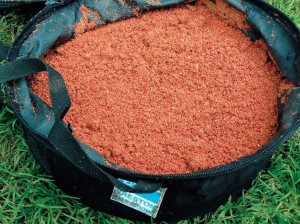 When using feeder gear, it is necessary to add large fractions to the traditional (basic) bait composition, which are capable of holding the bream in one place. If there are no large particles of food, then a flock of bream will very quickly collect bait and swim away, in search of something serious.
When using feeder gear, it is necessary to add large fractions to the traditional (basic) bait composition, which are capable of holding the bream in one place. If there are no large particles of food, then a flock of bream will very quickly collect bait and swim away, in search of something serious.
To make the bream feed in the intended place, you can add to the composition of the bait:
- boiled barley;
- boiled or canned corn;
- worms, finely chopped;
- steamed peas;
- maggot;
- bloodworm.
Flavors for bream
Fishing becomes more effective if different flavors are added to the bait, which can make the bait more attractive.
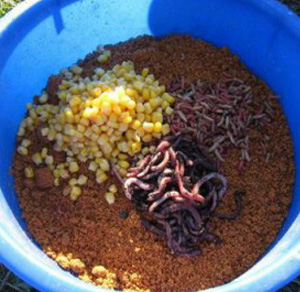
If the bait contains the smell of dill, then the bream is unlikely to swim by without trying it.
- Dill seeds can also be ground in a coffee grinder and added to the mixture at the rate of 2-3 teaspoons per 1 kg of the finished mixture.
- Having bought liquid flavors in the store, they can also be added to bait, but very carefully so as not to overdo it. Bream can be attracted to flavors of vanilla, strawberry, banana, apricot, etc. Before adding them to ready mix they should be diluted with water.
As a rule, anglers are divided into two categories: some are constantly experimenting and using baits made by their own hands to catch bream, while others go to the store and buy ready-made mixtures and use ready-made “chemistry” as flavors. This is a category of lazy anglers who go fishing not for pleasure, but for the result. For them, the more fish caught, the better, and they do not think much about the consequences of using store-bought flavorings.
As for the first category of anglers, they use fishing more as an element of rest and relaxation. Such fishermen are ready to stand near the stove and cook porridge with their own hands in order to attract fish. They are not upset if the fishing is not successful, but simply ready to come up with some other recipe for the next fishing trip. And so from year to year.
The bream is very shy and is not so easy to find on the pond. He is suspicious of everything: hooks, bait, even any noise on the shore takes hostility and goes into the depths. When catching this fish, you should be quiet. But you can lure him to the place of fishing with suitable bait.
The bream never refuses a good bait and actively reacts to it.
If we are talking about baits that are made independently, then you should follow some rules:
- Peas have always been considered the main ingredient for bait that bream loves. He always actively reacts to the smell of peas. If you add it to complementary foods, then the fish will only rejoice at this.
- Proportions must be observed when adding peas to complementary foods. It is not worth digesting, although the smell and taste remain, but after adding it, the mixture may blur, especially in the course. So peas do not need to be turned into puree, whole halves should remain in it.
- If barley is planned to be added to the bait, then before cooking it must be thoroughly washed to remove the viscosity. It is recommended even after the cereal is cooked, rinse it too. This process also applies to wheat.
- Millet must be cooked with care. In no case should it be digested, as it can ruin the entire bait. Bream and wheat do not disdain, which must be kept soaked for about two days.
- Maggot added to the bait brings a good effect. It can be added live or pre-scalded. Bloodworms are also used, which attract the attention of bream and small fish.
Ingredients
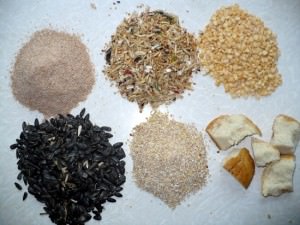 When it comes to food self cooking, then it should be remembered that large fractions of the product must be present in it. Since the bream is a large fish, reaching over 1 kilogram of weight, then complementary foods should be appropriate.
When it comes to food self cooking, then it should be remembered that large fractions of the product must be present in it. Since the bream is a large fish, reaching over 1 kilogram of weight, then complementary foods should be appropriate.
The list of ingredients is quite large, but the preferences of the fish should be taken into account.
What can be used:
- peas in any form;
- cereals from barley, millet, oatmeal, wheat;
- dry oatmeal;
- breadcrumbs;
- corn flour;
- cake and bran;
- peanut;
- roasted seeds;
- cornflakes;
- bloodworm, maggot, dung worms;
- canned corn and peas;
A considerable list of products can be added to this list, this is already curled from the imagination of the angler.
Flavors
 In order for the bait to have a more pronounced smell, various flavors are added to it. They are usually bought in the store, besides, they are not too expensive. When using them, you must follow the rules of the instructions.
In order for the bait to have a more pronounced smell, various flavors are added to it. They are usually bought in the store, besides, they are not too expensive. When using them, you must follow the rules of the instructions.
If attractants are added in small quantities, then the fish will not smell them, but if you overdo it, then you can completely scare away both bream and other individuals. Right Ratio complementary foods with flavoring, increase the efficiency of the catch by 80%.
What smells can attract bream:
- vanilla extract;
- anise oil;
- cinnamon and coriander;
- fennel and dill;
- garlic;
- strawberries, banana, pear (they are used to make boilies);
It is worth noting that bream likes sweet, fruity flavors. Vanilla is effective, and it also attracts other fish. In any case, you should always experiment, both with baits and flavors.
Recipes for homemade bait
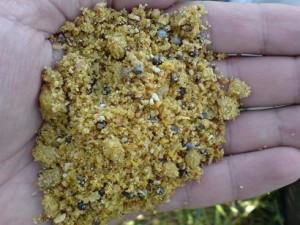 For bream, you need to harvest a lot of bait. You should always have a certain reserve with you, since fishing can be activated and you will have to feed the future trophy with something.
For bream, you need to harvest a lot of bait. You should always have a certain reserve with you, since fishing can be activated and you will have to feed the future trophy with something.
In specialized stores, ready-made bait is sold, but it is not cheap, and given the fact that you need a lot of it, pleasure can hit your pocket. The easiest and cheapest option is to prepare bait at home.
For this, inexpensive products and a little time are required.
Recipe #1:
- On slow fire you need to boil oatmeal and millet. During cooking, you need to make sure that the mixture does not burn, as there will be an unpleasant smell.
- Further preparation continues already at the place of fishing.
- Clay or sand is added to the porridge to keep the grain in shape.
- In the ready mixture crackers, sunflower and hemp seeds, vanilla extract, bloodworm or maggot to choose from are added.
- From the resulting mixture small balls are molded - 5-6 pieces and thrown into the water.
Recipe #2:
- Groundbait is done right before fishing.
- Bran mixed in a bowl, sunflower cake, corn sticks or cereal coffee drink, bloodworm and maggot.
- Water from the reservoir is added to this mixture. and clay, everything is kneaded to the state of a thick dough. You can let the bait brew for a few minutes.
- Then balls are molded and thrown into the water. During the fishing itself, you can make very small balls and throw them into the water to keep the fish in place.
Recipe #3:
- On the shore of the reservoir are mixed in one bowl the following ingredients: steamed peas, bran, flax seeds (fried), egg powder, freshly grated beets, worms, maggots, clay.
- After kneading balls are made and sent into the water.
Experienced anglers are always experimenting with bream food. But there is universal mixtures which work under almost any conditions.
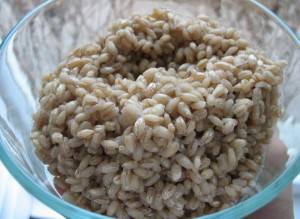 Recipe:
Recipe:
- in a saucepan it is necessary to boil 3-3, 3 glasses of water.
- Into boiling water, add 2.5 cups pearl barley. It must be cooked until half cooked.
- After that as barley swells, millet is added.
- To add flavor vanilla is used sunflower oil(unrefined).
- The porridge must be cooked until most of the water has evaporated.
- Thereafter the pan is turned off and covered with a lid and left for 40-45 minutes so that the remaining water is absorbed into the cereal.
- After this time porridge must be transferred to another container.
- into warm mixture add 3 cups barley groats and corn.
- At the fishing spot you can already add clay and water for better kneading.
Advice:
- Barley and millet groats nothing can be replaced.
- Instead of barley and corn grits you can use crackers, cake, store bait.
Feeding according to the season
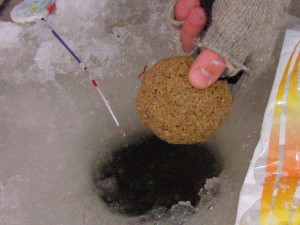 Ingredients for bait should be selected taking into account the time of the year, as bream's tastes and food needs change:
Ingredients for bait should be selected taking into account the time of the year, as bream's tastes and food needs change:
- For the summer period, the following recipe is suitable: Mixes into equal proportions cake, breadcrumbs, oatmeal, peas (sprouted) and 2 teaspoons of ground coriander. Clays can be added to the finished mixture for better viscosity. After that, balls are made and thrown into places where fishing is planned.
- For the summer period in stagnant water. Boiled until half cooked millet is mixed with bran. Next, breadcrumbs and sunflower seeds (better fried to add flavor), cinnamon and coriander in small quantities are added. On the shore of the reservoir, the mixture is kneaded with the addition of clay. After that, the food is ready for casting.
- For the autumn period. Breadcrumbs are mixed in a bowl, boiled rice, cake, bran (rye or wheat), ground coriander, finely chopped lard, worms or maggots. Then everything is done according to the previous kneading scheme.
- For the winter period. Peas, corn, hemp grains, peanuts, buckwheat are fried in a pan. During frying, the products must be constantly stirred so as not to burn. After that, all the ingredients must be ground in a meat grinder. In this mixture, you need to add crackers, bran, coconut flakes, a little cinnamon, cocoa, a pinch of salt and dried dill. As a result, you should get up to 1 kilogram of dry mix. Moisten it with water already in place and form small balls.
- For the spring period. Sunflower cake, boiled millet, fried bran, coriander and bloodworms (you need to take more of it) are suitable for preparing complementary foods - the fish at this time needs animal feed.
Lure for bream at the feeder
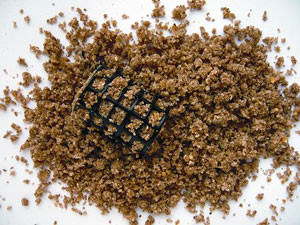 Large individuals, as a rule, are found at depth and it is very problematic to catch trophy bream from the shore. In this case, a feeder comes to the aid of the angler, with which you can perform a long cast.
Large individuals, as a rule, are found at depth and it is very problematic to catch trophy bream from the shore. In this case, a feeder comes to the aid of the angler, with which you can perform a long cast.
Bait for catching bream on the feeder can be purchased at the store, but fishermen with experience have adapted to cook it themselves at home. Traditional mixtures should contain large feed particles.
This is necessary so that when the feeder is cast, the mixture does not carry away with the flow. Usually barley, corn, peas, worms, maggots or bloodworms are added to the bait.
This is done in order to keep the bream in the same place. After all, in a matter of minutes he eats dusty food and goes further in search of food. And if there is real food at the bottom, then it will hold him.
Rules for the preparation and use of bait

The set of ingredients and the amount of bait is usually determined on the pond. Anglers prepare all the ingredients for the bait at home, and mix them before the start of fishing. The composition and preparation of complementary foods for bream depends on the weather and the current.
For water bodies with a large or moderate current, complementary foods with sufficient density are used. For this, heavy bait is used with the addition of soil fillers. For viscosity, you can use eggs, flour, bread, clay. In the course, complementary foods are thrown in small portions.
If fishing is planned for big fish, then there should be a lot of complementary foods, since small individuals always accumulate in places of casting in search of food.
With a weak current. balls of feed should wash out 30-45 seconds after casting. Heavier baits are thrown into the fishing spot in advance to keep the aquatic inhabitants in place.
Before casting, you can conduct a small test to determine the density of the ball. To do this, at a visible distance, they throw lure and observe how long it takes to wash away. The main components are sunflower cake and crackers. They are combined with an egg or powdered milk.
Weather conditions also affect fish behavior and bait selection. On hot days, the bream comes out in search of food in the evening or at dawn. On cloudy days warm days it is active throughout the day.
On such days, it is better to use bitter baits, for this, it is advisable to add dill or garlic. In warm weather, the bream prefers sweets, honey, vanilla should be added to the bait.
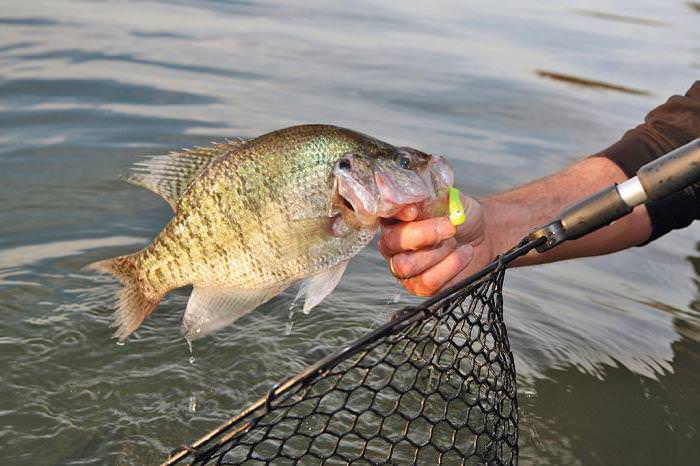
- The bream is a very cautious and shy fish., so on the shore you need to be quiet.
- Always experiment with food and flavors and find the best option.
- Large individuals, as a rule, are located at the bottom of the reservoir and away from the shore, so it is better to use a feeder with a feeder to catch it.
- Complementary foods must be done at home, and already directly on the fishing mix all the ingredients.
- For every period of the year different baits are prepared as the bream's tastes and needs change.
Fishing is considered to be such a type of recreation that makes it possible to restore the vital and spiritual potential of a person who spends most of his life in dusty and noisy cities.
In contact with
The opportunity to admire the landscape, philosophize, looking at the water surface, and also enjoy the catch - all this makes fishing not just a hobby, but even a way of life, and only a mushroom picker can compare with a fisherman, wandering through the forest for many hours and merging with nature.
Going on a fishing trip, you have no doubt already prepared a supply of tasty and attractive delicacies for fish. When you are going to catch bream, you should remember some points that will help you better understand its habits and make a real holiday out of fishing.
Let's look at the bream and its main qualities and habits.
Being an intellectual by nature, the bream is quite silent, shy, and sometimes cowardly. However, having lost vigilance, the bream can start to “thresh” without stopping. Being quite shy and irritable, the bream is morally stable. All spring until the end of May, the bream feasts, consuming bloodworms, worms and other meat delights. Since June, he has been on a fairly strict diet, eating only grains and cereals, preferably steamed ones.
Being a gourmet prefers the addition of aromatics: anise, garlic. Starting from the end of August, the bream relaxes and begins to consume lightly fried bacon, then again actively leans on meat delicacies.
When communicating with fishermen, the bream gives a clear preference for thin and ultra-thin gear, and simply ignores those who use coarse gear. Respecting the fine rain, fishermen are pleased with the activity of biting.
How can you please such a selective and fastidious fish?
To whet the appetite of the bream experienced anglers recommend using roasted buckwheat, millet, peas and oatmeal. As bait, bran steamed overnight is used.
There is interesting advice add milk powder to the bait, which, dissolving in water, creates a cloudy cloud that attracts bream. It will not allow the fish to get enough too quickly and quickly leave the fishing spot.
Flavorings added to the bait also attract bream. Garlic and dill extracts and anise oil are classic additions to bream fishing, and there are also tips for adding vanilla, cinnamon and fruit essences to baits.
In order for the fish not to become saturated too quickly, and also to prevent the decomposing influence of the reservoir on the food, it is advised to grind all the components of the bait. When going fishing for bream, it is better to take several types of bait with you, because bream is a wayward fish, and for one clear reason, he may not want to eat his usual bait.
Since a lot depends on natural and weather conditions, time of year and day, as well as the mood of the fish itself, then some there is no special universal recipe for bait. In addition, in different reservoirs and fishing can have different results. However, each fisherman praises his own type and composition of bait, and therefore we will consider a few various kinds prikormok, enjoying the greatest popularity.
How to prepare bait for bream (recipe, composition)?
How to make, cook bait for bream? Here are the most universal recipes bait. For example, such bait for bream from porridge.
Ingredients:
- oat flakes "Hercules" - 250 g (preferably ground and slightly fried);
- millet - 250 g;
- sunflower seeds - 150 g (roasted and ground);
- breadcrumbs - 500 g;
- hemp seeds - 150 g (roasted and ground);
- vanillin powder - ½ teaspoon;
- chopped bloodworm, maggot, worms.
Preparation of bait for bream:
- A mixture of cereals is cooked over low heat, avoiding burning. Should work viscous porridge which will be easy to mold.
- Further preparation is carried out immediately before fishing, while local clay, sand and water are added. With their addition, the cereals are kneaded into a thick mass, to which the remaining components are added.
- From the resulting fairly thick bait, balls are molded (about the size of a fist) and 4-5 balls are thrown into the pond to attract fish.
- During fishing, such balls are also periodically thrown into the water, but the balls must be smaller so as not to frighten the fish.
Being a glutton bream requires enough a large number bait. Therefore, it will be useful to prepare its stock in case of active fishing. Here is another recipe for bait for bream.
Ingredients:
- bran - 2 parts;
- ground sunflower cake - 3 parts;
- ground corn sticks - 1 part;
- ground dry clay - 1 part;
- ground dried mayfly - ½ part;
- coffee drink - ½ part;
- small bloodworm - 5 parts;
- small maggot - 3 parts.
Cooking: All components are mixed immediately before the start of fishing with the addition of local clay and water until the consistency of a thick dough. Balls are molded from it, which are thrown into the water in order to attract fish.
If bream fishing is carried out in summer time, due to the presence of a sufficient amount of natural food, the bream eats the bait weakly. For this reason, depending on the weather, they make up very specific baits.
Recipes for homemade bait for bream in the summer
 The recipe for bait for bream in the summer, especially at the very beginning of summer, this recipe is relevant and leads to a successful biting.
The recipe for bait for bream in the summer, especially at the very beginning of summer, this recipe is relevant and leads to a successful biting.
Ingredients:
- Boiled "Hercules" - 500 g;
- Bran - 300 g;
- Sunflower cake - 300 g;
- Maggot - 3 matchboxes;
- Motyl - 5 matchboxes;
- Ground coriander - 3 teaspoons;
- Breadcrumbs - 100 g;
- Sand and clay.
The method of how to prepare bait for bream is quite similar to the previous recipes, so we will not dwell on it separately.
Here is an example of a recipe that is successfully used when fishing for bream on a cool summer day:
Ingredients:
- boiled millet - 300 g;
- Bran - 200 g;
- Motyl - 5 matchboxes;
- Sunflower cake - 300 g;
- Sand and clay.
At the very beginning of summer, bait with vegetable and animal components is used, since it is at this time that the bream actively grows and feeds. V this case use this recipe for bait:
Ingredients:
- Boiled "Hercules" - 500 g;
- Bran - 300 g;
- Sunflower cake - 250 g;
- Maggot - 3 matchboxes;
- Bloodworm - 5 matchboxes.
- Sand and clay.
Spices:
- ground coriander - 3 teaspoons;
- vanilla breadcrumbs - 100 g
The grains that make up the bait are its most nutritious part, which attracts the fish and allows it to get enough. The bream, capable of training, returns to the “satiating” site again and again.
Millet is one of the best cereals for the preparation of baits for bream. To obtain the best consistency of millet porridge, use 1 part millet and 2 parts water.
Simple bait for bream
Ingredients:
- boiled millet - 2 kg;
- Breadcrumbs - 200 g;
- Sunflower cake - 300 g;
- Powdered milk - 100 g;
- Caramel - 20 g;
- Anise - 10 g.
Of course, there is no universal bait that will help you always get a rich catch of bream in any weather and in any water body. However, you will get pleasure from the process of fishing in any scenario. And you will return to the city rested, refreshed and in a great mood!
Good luck to you!


